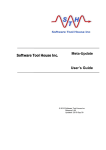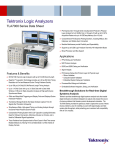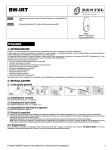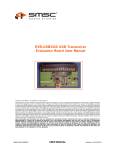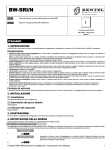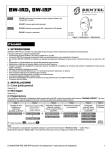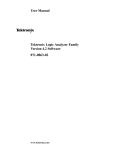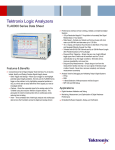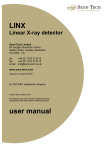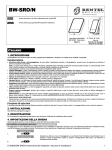Download HT Preprocessor User`s Manual
Transcript
The Moving Pixel Company HTPP User’s Manual – Doc. Rev. 1.20 -- 6/14/05 HT Preprocessor User’s Manual 1 General Description The HTPP (HT Preprocessor) is an instrument that serves as front-end Hypertransport (HT) stream acquisition hardware for a Tektronix logic analyzer (TLA). One or two Tek P6880 (or P6980) probe connections are provided, each supporting one (up to) 2.8 Gb/s, 8- or 16-bit HT unidirectional link. In conjunction with a TLA, the solution features filtering, packing, acquisition, and disassembly (i.e. low-level protocol interpretation) of incoming data from its HT links. More specifically, the HTPP monitors the physical and link layer HT protocol starting with bit-time0 identification and data alignment as well as continual real-time periodic CRC checking. Unused data from CAD15-CAD8 during 8-bit link operation are discarded and the data repacked for efficient processing and storage. HT data may be selectively filtered according to HT packet type or arbitrary field pattern-matching criteria evaluated for HT packet selection. Similarly, general pattern-matching trigger criteria can be evaluated for TLA triggering. Finally, HTPP output data is forwarded to the TLA for capture and disassembly. The HTCtl Windows GUI provides a simple interface for controlling the HTPP instrument via USB. It allows for field-update of the HTPP firmware, reflects basic hardware status, selects operational modes of the HTPP, and allows identification of HT packet types for filtering, and HT field pattern-matching criteria for triggering. These criteria are specified by the user by identifying a packet type, then filling in desired field values with binary masks consisting of ‘1’, ‘0’ or ‘X’ for don’t care. The HTPP instrument may be configured with one or two modules, which are for the most part fully independent (though simple cross-triggering is supported and they share a common clock). Each module of the HTPP monitors one HT stream, requires one 136channel TLA module1, has its own USB connection, and is controlled by its own GUI. Generally, the two modules are used for the upstream and downstream monitoring of a single duplex HT link. On the TLA, a bus support is provided for viewing acquired HT data. Data output to the TLA consists of 136-bit records comprising 128-bits of HT packet data plus several 1 Running at ~200 MHz DDR. Note this speed requires TLA7AXX high-speed acquisition modules for correct operation. Page 1 of 23 The Moving Pixel Company HTPP User’s Manual – Doc. Rev. 1.20 -- 6/14/05 control signals such as master clock, valid, and record type bits. In addition to the most common “Data record” type, which is just packed HT packet data, the HTPP hardware also outputs CRC records and Special records. The CRC record passes periodic checksum information extracted from the HT stream, along with valid flags to indicate successful real-time CRC verification. The Special record encodes custom HTPP information for the disassembler to use and display including: packet alignment, trigger information, configured link width, protocol error bits, and sub-sampled values for slow HT and user signals. Please consult the HTPP TLA Support Users Manual for more detailed information. 2 HTPP Interfaces The HTPP has the following interfaces: Front Panel: Module 1 (downstream) - P6880 Connector to HT hardware under test - Loop-back test connector - Link reset push button - Two LED indicators Module 2 (upstream) - P6880 Connector to HT hardware under test - Loop-back test connector - Link reset push button - Two LED indicators Rear Panel: Line Power Module 1 (downstream) - USB Connector (1.1 or 2.0) - Two 68-channel Samtec connectors to TLA Module 2 (upstream) - USB Connector (1.1 or 2.0) - Two 68-channel Samtec connectors to TLA As mentioned, each module operates entirely independent from the other. Thus, each has their own set of connectors and indicators. The loop-back test connectors output a slow speed (188 MHz DDR) HT test stream useful for HTPP and TLA verification. The reset push button resets the channel, putting the HTPP module in its power up state, waiting for a HT cold/warm reset sequence (assuming normal mode of operation – see next section for more details). LED1 marked “Active” indicates the link is operating correctly and valid periodic CRCs are being received on the HT link. LED2 marked “Trigger” indicates when a trigger condition as configured by the HTCtl GUI has occurred. Page 2 of 23 The Moving Pixel Company HTPP User’s Manual – Doc. Rev. 1.20 -- 6/14/05 3 HTPP Operation In the following discussion, HTPP refers to one HTPP link module operating in normal mode (i.e. not in “No CRC” mode, “Raw” mode, or one of the “Bypass” modes in the Debug menu). After powering on the HTPP hardware, the HTCtl application should be started and the configuration downloaded to the instrument (via the “Config Send” button). After power-up, the HTPP waits for an HT cold-reset initialization sequence. At least one cold-reset is required before HTPP power-up initialization is complete. By the end of cold-reset, the HTPP has detected bit-time0 and properly aligned incoming data to 32-bit words. Subsequent cold or warm reset sequences (whether initiated by Reset or LDTStop) are automatically detected by the HTPP, resetting internal state appropriately. For triggering purposes, the user may choose to use the link reset push-button on the HTPP or the “Reset Link” button in the HTCtl GUI to reset the hardware to its “waiting for HT reset” state (suspending output to the TLA until after the reset sequence is seen).2 Clock speed changes during warm reset are handled automatically by the HTPP. On the other hand, as the HTPP does not interpret HT configuration register write cycles on the link, the link width setting is assumed to be whatever the user has indicated the link width will be after warm reset (using HTCtl). Incorrectly identifying the link width in HTCtl will result in erroneous operation. Having identified bit-time0 following HT reset, the HTPP can determine when periodic CRCs occur in the HT stream and verify that they are correct. As previously mentioned, periodic CRC information is output to the TLA as separate CRC records. Note that packet CRC checking (in link retry mode) is not currently supported in the HTPP. The TLA disassembly will merely identify the packet CRC as HT data words. The HT input stream to an HTPP module consists of the following 24 signals: CAD[15..0], Ctl[3..0], PowerOK, Reset, LDTStop, LDTReq, and Usr[3..0]. In 8-bit links, CAD[15..8] are unused. Due to system bandwidth constraints, the HTPP processes the HT signals in different ways. The CAD bits are packed into 128-bit records (stripping CAD[15..8] for 8-bit link widths). For each 128-bit record, only 4 of 16 associated Ctl bits are carried, one for each 32-bit word. With the exception of the CRC in packet retry mode, all of the Ctl bits associated should be identical. If they are not, this is an error condition reported to the TLA by the HTPP via the CtlMismatch flag. The slow HT signals – PowerOK, Reset, LDTStop, and LDTReq – are subsampled at approximately 15 MHz, which is the output frequency of the Special record. Similarly, three user signals are supported3, but with additional aggregating logic that allows 188 MHz samples of the signals to be ANDed (for active low signals) or ORed (for active 2 The reset push-button acts as a hard reset and requires a subsequent cold HT reset sequence to complete re-initialization (as with power on). The ‘Link Reset’ GUI button is a ‘softer’ reset allowing either cold or warm reset sequences to initiate normal operation. 3 Actually, user signals are currently not supported as of firmware release 1.3. Please contact the Moving Pixel Company for more information. Page 3 of 23 The Moving Pixel Company HTPP User’s Manual – Doc. Rev. 1.20 -- 6/14/05 high signals) before output at the 15 MHz rate. The user identifies Usr signals as active high or active low in the HTCtl GUI. After the HTPP has initialized and been configured, and a cold reset sequence has completed, record output to the TLA begins. TLA acquisition, of course, doesn’t begin until set to run and the TLA trigger state machine conditions have been satisfied. The next section describes the HTCtl application, including details on setting up HT field pattern-matching terms for the TLA to use for triggering (see the HTPP TLA support users manual for more detail on HT data acquisition using the TLA). 4 HTCtl HTCtl.exe is a Windows application to configure and control the HTPP instrument, running under Windows 98, ME, NT, 2K, and XP. Install by running Setup.exe off of the distribution CD ROM, which by default locates the application directory in “C:\Program Files\TMPC\HTBSP”. HTCtl communicates with an HTPP module via USB. A multi-port USB mini-hub is provided for connection to multiple modules within an HTPP and/or multiple HTPP instruments. Each module has a unique identifying serial number (marked on the HTPP front panel) that is used by the HTCtl application to select among multiple modules. For convenience, HTPP modules are labeled “upstream” and “downstream” intended that they be paired as two unidirectional links of a single, duplex HT link. By convention, upstream modules have an odd serial number and downstream modules have an even serial number. One instance of HTCtl controls one HTPP module. When the application is started, the USB driver is queried for the serial numbers of HTPP modules connected to the machine and the results are displayed for the user to select. Once selected, subsequent instances of HTCtl will not be allowed to acquire the same HTPP module (until the application that owns it is closed). After HTCtl acquires the HTPP module, it loads the saved configuration associated with the serial number from a file located in the application directory. This configuration file is automatically saved at application exit. In addition, the user may save and restore his own configuration files using the “File->Save Cfg” or “File->Load Cfg…” menu options. The main functions of HTCtl are to: • Configure HT packet filtering based on packet type • Set up pattern-matching trigger criteria • Set up operational modes of the HTPP • Display current HTPP status • Update HTPP firmware Each of these functions is described in the following sections. Page 4 of 23 The Moving Pixel Company HTPP User’s Manual – Doc. Rev. 1.20 -- 6/14/05 Figure 1 – HTCtl Main Window 4.1 HT Packet Filtering Figure 1 shows the HTCtl main window. This section concerns controls in the frame labeled “Filter Pkt Types”. One of the features of the HTPP hardware is the ability to filter HT packets forwarded to the TLA based on packet type. Because one TLA output record (with 128 HT data bits) contains multiple HT packets, two filtering cases are possible. The first case is when all the HT packets in a given record are to be filtered. In this case, the Valid record flag is simply cleared, causing the TLA not to acquire it. This reduces TLA memory used for acquisition. The second filtering case is when only some of the HT packets contained in a TLA record are to be filtered. Here, the HTPP replaces the Cmd field of filtered packets with a Page 5 of 23 The Moving Pixel Company HTPP User’s Manual – Doc. Rev. 1.20 -- 6/14/05 reserved Filter Cmd value designated by the user. Using the “Filter Cmd” selection box, the user designates a HT reserved-HOST value for the HTPP hardware to use for flagging filtered packets. Filtered packets are not seen by the user and are discarded by the disassembler. Note that the Filter Cmd value in HTCtl must match the Filter Cmd value set in the disassembler on the TLA (disassembly options) for correct filtering operation. To filter certain types of packets, simply check the associated check boxes associated with the unwanted packet types and click the “Send Config” button. Note that filtering applies to both extended address control packets and their non-extended address equivalents. Due to the HTPP’s treatment of HT data words as an independent “packet type” (i.e. not associating data words with their packet headers)4, filtering a packet type that has data without also filtering HT data words will leave “orphaned” data in the disassembler output. However, there should be no ambiguity identifying orphaned data words from data words associated with a packet of interest (due to the HT restriction that no intervening packets between a packet header and its data can themselves have data). In addition to packet types and data words, two additional check boxes are provided. The “CRC” check box filters CRC records and the “Limit Special” check box requests that the HTPP not output more than one Special record between unfiltered data records. Special records are required for packet data alignment so they cannot be entirely filtered. But using the “Limit Special” function, TLA traces that capture sparse occurrences of a particular packet type can significantly reduce the number of Special records captured. The TLA disassembly support also allows removing Special records from the display, but using this feature does not conserve TLA capture memory. Note that limiting Special record output also reduces the sub-sampling of slow HT and user signals, so this feature is not recommended when these signals are important to view. Moreover, in the strange event that the packet causing the trigger event is filtered (perhaps along with other packet types), TLA triggering may be delayed waiting for an unfiltered special record to be output (which won’t happen with the “Limit Special” function enabled until an unfiltered HT packet is output). For convenience, the “Set All” and “Clr All” buttons beneath the filter check boxes set all or clear all of the check boxes respectively. 4.2 Trigger Configuration Because of the parallel nature and unknown formatting (to the TLA) of the captured data, triggering on specific values of specific HT packet fields is not generally possible by the TLA without hardware assistance. To this end, the HTPP hardware and the HTCtl GUI provides this assistance, allowing the user to specify terms for pattern matching based on HT packet type and field values. The result of this pattern matching is available as a trigger flag in the Data record and also latched trigger bits in the Special record for both 4 The main difficulty of associating Hypertransport data words with their control packets is that additional control packets (with no data) can be interposed between a packet header and its data. Page 6 of 23 The Moving Pixel Company HTPP User’s Manual – Doc. Rev. 1.20 -- 6/14/05 the upstream and downstream HTPP modules). This represents the most common method for triggering the TLA. The pattern-matching trigger criteria are organized essentially as a sum-of-products equation with up to four terms. Each term corresponds to a collection of packet field masks, in which the user indicates bits of interest as a ‘0’ or a ‘1’ and bits not of interest as an ‘X’ (don’t care). 5 The user first chooses a term with the “Prev/Next Term” arrows and selects a packet type with the “Pkt Type” selection box. This fills in corresponding fields labels and editable masks for the given packet type for the user to modify. For convenience, the field masks are initialized from a saved template that records the last settings for each packet type. All field masks for the current term may be cleared (i.e. set to don’t care) using the “Clear Masks” button and all terms may be set to ‘unused’ using the ‘Reset Config’ button. As a shorthand facility for entering addresses in hexadecimal (rather than binary), the Addr button is provided. The button always displays the current address mask in hexadecimal with ‘X’ for don’t care nibbles. Clicking on the button brings up a dialog allowing the user to change the address mask fill in the HT packet address bits appropriately. Further bit editing of fields may subsequently be necessary for finer specification. When creating new trigger criteria, be sure to check that all terms are set properly (it is easy to edit only one term and forget about the previous settings of other terms). The “Pkt Type” for unused terms should be set to “unused”. To enable address extension fields for the current term, check the “Address Ext” check box. Note that extended address control packets are considered distinct from their equivalent non-extended address control packets for triggering purposes. If triggering on both types is desired, two terms are required, one for each type. The 2-bit ‘RecType’ group in the TLA disassembly is used to flag Data records that contain an HT packet that matches the trigger criteria (as well as differentiate Data records from Special and CRC records). Thus, the TLA will generally be configured to trigger on (RecType == TRIGGER_DATA). Note that (RecType == TRIGGER_DATA) does not uniquely identify the HT packet satisfying the trigger criteria. The user must consider which among eight possible HT packets contained within the record actually caused the trigger.6 In addition, two trigger bits are latched and forwarded in the Special record to the TLA and displayed in the ‘Trigger’ disassembly group. Bit 0 (local trigger) and bit 1 (cross trigger) in the ‘Trigger’ group indicate the latched trigger state of the local and alternate 5 Clearly, the HTPP triggering methodology ideally could be made more powerful, in particular offering inequality field comparisons, negation, and sequential trigger state machines. Though implementing more sophisticated triggering is problematic given current logic resource constraints, the Moving Pixel Company welcomes feedback in order to gauge the practical needs of our customers for future revisions. 6 On the TLA, data records contain 128-bits of HT data, or up to 4 HT packets. Internally, the HTPP maintains data records containing 256-bits of HT data, or up to 8 HT packets. Thus, the TRIGGER_DATA record type always appears in pairs on the TLA. Page 7 of 23 The Moving Pixel Company HTPP User’s Manual – Doc. Rev. 1.20 -- 6/14/05 HTPP modules respectively, i.e. whether at least one HT packet has satisfied its respective module’s configured trigger criteria since the user last requested trigger reset. These bits are offered to the user more as trigger status, and are not as useful for TLA triggering. The “Wait For Cross Trigger” check box inhibits local triggering until the cross trigger flag is true. This allows, for example, triggering on the first response packet on the downstream link following a specific request on the upstream link. Note however, because of device latency and pipelining there is no implicit guarantee that the triggered response packet will be the response packet associated with the triggered request packet. The user must match the UnitID/SrcTag fields to correctly match request/response pairs. The “Disable Trigger” check box inhibits triggering on the HTPP module. This is required for setting up cross-triggering scenarios using two HTPP modules and two HTCtl GUIs. Specifically, triggers need to be disabled on the upstream link until both the upstream and downstream links have been configured. Then, the “Disable Trigger” check box is unchecked to re-enable the system. The “Use Trig As Select” check box replaces filtering by packet type. Instead, only packets that satisfy the trigger criteria are forwarded to the TLA for disassembly. Trigger examples: 1) Trigger on IO Port 80 byte write. Configure the HTCtl GUI as follows: Term 1: 1) Select the "Write Request" Pkt Type. 2) Set the "Data Length" field = 0 (for byte writes) 3) Set the Addr field to 0xfdfc000050 3a) Set the "Addr[39:32]" field to: '11111101' 3b) Set the "Addr[31:24]" field to: '11111100' 3c) Set the "Addr[23:16]" field to: '00000000' 3d) Set the "Addr[15:8]" field to: '00000000' 3e) Set the "Addr[7:2]" field to: '010100' Then set up the TLA to trigger on: Group RecType == TRIGGER_DATA. 2) Trigger on PCI Config write to dev 0, func 0, offset 40h This is similar to the example above, with the exception that there are two types of HT Configuration cycles (type 0 and type 1). The two types are distinguished by different base addresses (0xfdfe000000 and 0xfdff000000) and type 0 cycles use the current bus rather than use the bus field in the address. Page 8 of 23 The Moving Pixel Company HTPP User’s Manual – Doc. Rev. 1.20 -- 6/14/05 We can set up the trigger in two ways, with a “don't care” in address bit 24, or with two terms: First (easiest) approach: Term 1: 1) Select the "Write Request" Pkt Type. 2) Set the Addr field to 0xfdf (111X) 000040 2a) Set the "Addr[39:32]" field to: '11111101' 2b) Set the "Addr[31:24]" field to: '1111111X' 2c) Set the "Addr[23:16]" field to: '00000000' 2d) Set the "Addr[15:8]" field to: '00000000' 2e) Set the "Addr[7:2]" field to: '010000' Second approach: Term 1: 1) Select the "Write Request" Pkt Type. 2) Set the Addr field to 0xfdfe000040 2a) Set the "Addr[39:32]" field to: '11111101' 2b) Set the "Addr[31:24]" field to: '11111110' 2c) Set the "Addr[23:16]" field to: '00000000' 2d) Set the "Addr[15:8]" field to: '00000000' 2e) Set the "Addr[7:2]" field to: '010000' Term 2: 1) Select the "Write Request" Pkt Type. 2) Set the Addr field to 0xfdff000040 2a) Set the "Addr[39:32]" field to: '11111101' 2b) Set the "Addr[31:24]" field to: '11111111' 2c) Set the "Addr[23:16]" field to: '00000000' 2d) Set the "Addr[15:8]" field to: '00000000' 2e) Set the "Addr[7:2]" field to: '010000' In either case, as before, set the TLA to trigger on: Group RecType == TRIGGER_DATA. 3) Conditionally capture all IO Reads and Write to CMOS registers IO ports 70, 71, 72 and 73. Triggering and filtering on field ranges can only be done in the HTPP using don't care bits. Thus, ranges are limited to those aligned and sized as powers of two. Moreover, writes to specific byte lanes within a double word can only be decoded using the mask bits contained in the data words following the packet header. Page 9 of 23 The Moving Pixel Company HTPP User’s Manual – Doc. Rev. 1.20 -- 6/14/05 Since 70-73 maps to 0x46-4a hex, the best we can do is widen the address range to an aligned power of two, i.e. 0x40-4f, or use two terms to reduce the range to a smaller superset, i.e. 0x44-0x47 and 0x48-0x4c to span the range 0x44-0x4c. Also, since we want to capture both both reads and writes, we must use two terms for each aligned address range. Set the trigger terms in the HTCtl GUI as follows: Term 1: 1) Select the "Write Request" Pkt Type. 2) Set the Addr field to 0xfdfc00004 (01xx) 2a) Set the "Addr[39:32]" field to: '11111101' 2b) Set the "Addr[31:24]" field to: '11111100' 2c) Set the "Addr[23:16]" field to: '00000000' 2d) Set the "Addr[15:8]" field to: '00000000' 2e) Set the "Addr[7:2]" field to: '010001' Term 2: 1) Select the "Write Request" Pkt Type. 2) Set the Addr field to 0xfdfc00004 (10xx) 2a) Set the "Addr[39:32]" field to: '11111101' 2b) Set the "Addr[31:24]" field to: '11111100' 2c) Set the "Addr[23:16]" field to: '00000000' 2d) Set the "Addr[15:8]" field to: '00000000' 2e) Set the "Addr[7:2]" field to: '010010' Term 3: 1) Select the "Read Request" Pkt Type. 2) Set the Addr field to 0xfdfc00004 (01xx) 2a) Set the "Addr[39:32]" field to: '11111101' 2b) Set the "Addr[31:24]" field to: '11111100' 2c) Set the "Addr[23:16]" field to: '00000000' 2d) Set the "Addr[15:8]" field to: '00000000' 2e) Set the "Addr[7:2]" field to: '010001' Term 4: 1) Select the "Read Request" Pkt Type. 2) Set the Addr field to 0xfdfc00004 (10xx) 2a) Set the "Addr[39:32]" field to: '11111101' 2b) Set the "Addr[31:24]" field to: '11111100' 2c) Set the "Addr[23:16]" field to: '00000000' 2d) Set the "Addr[15:8]" field to: '00000000' 23) Set the "Addr[7:2]" field to: '010010' Finally, instead of triggering, we want to capture only records that satisfy the trigger condition. To do this we check the check box "Use Trig As Select". Page 10 of 23 The Moving Pixel Company HTPP User’s Manual – Doc. Rev. 1.20 -- 6/14/05 As usual the TLA can be set to trigger on: Group RecType == TRIGGER_DATA. 4) Trigger on ReadResponse to MMIO readSized to PMIO space, offset 10 This requires setting up a trigger on the upstream link module, followed by a trigger on the downstream link module. (Here, ‘upstream’ describes the link containing the request packet and ‘downstream’ describes the link containing the response packet.) Currently, the cross-triggering capability between HTPP modules is limited to use of the cross trigger flag, which can be used in the trigger criteria by checking the “Wait For Cross Trigger” check box. It will be up to the user to match specific upstream request, downstream response pairs via their UnitID and SrcTag fields. Probably the best way to limit searching through the downstream trace results is to make use of the "Use Trig As Select" option to filter the downstream responses. Upstream Module (master trigger) Term 1: 1) Select the "Read Request" Pkt Type 2) Set the Addr field to 0xfdfc00000 (10xx) 2a) Set the "Addr[39:32]" field to: '11111101' 2b) Set the "Addr[31:24]" field to: '11111100' 2c) Set the "Addr[23:16]" field to: '00000000' 2d) Set the "Addr[15:8]" field to: '00000000' 23) Set the "Addr[7:2]" field to: '000010' Set up the upstream TLA module to trigger on: Group RecType == TRIGGER_DATA Again, we can only trigger on power-of-two address ranges, so the upstream trigger will fire on I/O offsets 8-15. If desired, check the "Use Trig As Select" check box to limit the upstream records captured by the TLA. Downstream Module (slave trigger) Term 1: 1) Select the "Read Response" Pkt Type Check the “Wait For Cross Trigger” check box Set up the downstream TLA module to trigger on: Group RecType == TRIGGER_DATA. Page 11 of 23 The Moving Pixel Company HTPP User’s Manual – Doc. Rev. 1.20 -- 6/14/05 If desired, check the "Use Trig As Select" check box to limit the downstream records captured by the TLA. Coordination is required in setting up triggers for both the upstream and downstream modules. We must first clear and prevent the upstream trigger from occurring until both modules have been configured. To do this, check the “Disable Trigger” check box on the upstream module’s HTCtl GUI. Then, proceed to configure the upstream and downstream modules as described above. Finally, uncheck the “Disable Trigger” check box to allow triggering to occur. 4.3 Operational Configuration and Control Other controls in the HTCtl window are described below: Link Width: These option boxes declare the link width after an HT warm reset sequence. As the HTPP hardware does not interpret configuration write messages, the user must specify this setting for correct HTPP operation after warm reset. Usr Config: These check boxes indicate whether Usr bits are active high or active low. This information is used to determine the aggregation method of each Usr signal 15 MHz sub-sampling for output in the Special record. Active high signals undergo logical OR aggregation. Active low signals undergo logical AND aggregation. Send Config: This button sends the current configuration including filter and trigger criteria, link width, and Usr config options to the HTPP module. Link Reset: This button resets the HTPP module, disabling TLA record output until a cold or warm HT Reset sequence is seen on the link. Its use is not necessary for correct operation of the HTPP, as cold and warm reset sequences are automatically detected in hardware. However, this button can be helpful for capturing staged events on the HT link, by putting the HTPP in a quiescent state to prevent the TLA from triggering prematurely. Trigger Reset: This button clears the latched local and cross trigger flags. Assuming trigger events are not continually occurring, the Trigger and CrossTrigger GUI status LEDs will turn red. 4.4 Status Display Several status LEDs are provided in the HTCtl main window: • ‘HT Clk’ green indicates transitions are occurring on the input HT clock. • ‘Bit Time0’ green indicates the HTPP has seen an HT reset sequence and HT data is passing through the instrument. • ‘CRC Error’ green indicates no CRC errors have occurred seen since the last HT link reset or press of the ‘Trigger Reset’ button. Page 12 of 23 The Moving Pixel Company HTPP User’s Manual – Doc. Rev. 1.20 -- 6/14/05 • • ‘Trigger’ green indicates the trigger condition has fired since the last HT link reset or press of the ‘Trigger Reset’ button. The state of this flag is also indicated by the bit 0 in the Trigger group during the special record. ‘Cross Trigger’ green indicates the trigger condition from the alternate HTPP module (if present) has fired since the last HT link reset or press of the ‘Trigger Reset’ button (from the alternate link’s HTCtl GUI). Link Width indicates the current (assumed) link width based on the link width setting and whether a warm reset sequence has been seen. 4.5 Self-test Two options in the Debug menu control the loop-back self-test capability of the HTPP. Checking the ”Run Self-Test” option starts the internal (low-level) HT generator outputting data to the self-test connector on the HTPP front-panel. It is intended for loopback connection to the input for self-test validation. Uncheck this option to stop the selftest generator (and uncheck and recheck to restart). The “Self Test Config…” menu option (Debug menu) is used to determine the data sent to the front-panel connector. This option brings up the self-test configuration dialog allowing the user to specify either a playback file (which in turn can be either a high-level HT file or a low-level pattern file) or check a box to indicate the HTPP should play the default self-test sequence. Data is output on the self-test connector at about 188 MHz DDR using the currently selected link width of 8- or 16 bits, and loops repeatedly. 4.5.1 Default Self-Test The default self-test contains an arbitrary collection of HT packet data, intended to demonstrate a typical HT listing and validate cable connections and correct box operation. Obtaining a valid Active light on the front-panel or a Green LED light on the HTCtl GUI is evidence of correct self-test operation. The self-test pattern begins first with an HT cold-reset sequence, though due to internal memory constraints the sequence is not a legal HT reset sequence with very short PowerOK and Reset# pulses. However, the sequence is sufficient for the HTPP module to recognize. Second, HT packet data is output, starting with an initial CRC block (512 bit-times) then looping on four subsequent CRC blocks in such a way that the periodic CRC fields remain valid. Page 13 of 23 The Moving Pixel Company HTPP User’s Manual – Doc. Rev. 1.20 -- 6/14/05 It should be noted that the HT packets output by the self-test generator, while structurally legal, are not necessarily meaningful at higher HT protocol layers. For example, packets are constructed with arbitrary patterns filling the fields. (e.g. the rxNextPacketToAck field in NOP packets is an incrementing counter and many of the addresses are set to 0x123456789a) and a Sync Packet may arbitrarily show up in the various types of packets that are output. Please consult the TLA refmem SelfTest.tla included with your software release to see a trace of the self-test generator output. 4.5.2 High-Level User Self-Test Files The user may construct his own looping self-test test file with valid HT data as follows. • • • • • • • • • • Each line consists of HT Ctl bit (0 or 1) and HT Data (32-bit hex value) separated by a comma. The first line must have Ctl set to 1 (for proper identification of bit-time 0) Null lines are okay Comment lines are okay if they begin with '#' Exactly 4 CRC blocks must be provided (pad with NOPs if necessary) For 8-bit mode, each CRC block is 128 32-bit words (thus 4*128 = 512 lines total in file) For 16-bit mode, each CRC block is 256 32-bit words (thus 4*256 = 1024 lines total in file) A warm reset sequence will be prepended to the data Correct periodic CRC bytes will be inserted into data No control of HT Reset, PowerOK, LDTStop, LDTReq, Usr signals is provided. To play the user self-test file (and loop repeatedly), bring up the self-test configuration dialog with the menu option “Debug->Self Test Config…”. Type in or browse for the appropriate self-test file, uncheck the “Use Default Self-Test” option and click OK. Check (or uncheck and recheck) the “Debug->Run Self Test” to begin playback. 4.5.3 Low-Level User Self-Test Files For low-level hardware debugging -- i.e. to validate probe, connector, cabling, and TLA acquisition capability – self-test files containing rudimentary data patterns may be played out the self-test connector. These files have the following syntax: • • • • • • • The first line has the following string “# TMPC DEBUG”. Each line contains one 24-bit hex value representing one bit-time LSB contains CAD7-0 Middle byte contains CAD15-8 (ignored in 8-bit mode) MSB contains control signals as follows (MS bit to LS bit) (Usr2, Usr1, Usr0, LDTReq, LDTStop, Reset, PowerOK, Ctl) An even number of values are required for correct looping. The maximum number of values is 512. Page 14 of 23 The Moving Pixel Company HTPP User’s Manual – Doc. Rev. 1.20 -- 6/14/05 To play the user self-test file (and loop repeatedly), bring up the self-test configuration dialog with the menu option “Debug->Self Test Config…”. Type in or browse for the appropriate self-test file, uncheck the “Use Default Self-Test” option and click OK. Check (or uncheck and recheck) the “Debug->Run Self Test” to begin playback. 4.5.4 Raw Mode Data Capture Raw Mode allows raw HT input data to be passed to the TLA without filtering, processing, or disassembly (only packing). This mode is a low-level mode for data capture on the HT link before bit-time0 or when there is a cabling, connector, or other hardware error preventing valid HT data from being acquired. Because of the bandwidth limitation between the HTPP and the TLA, only HT clock speeds of up to 600 MHz are supported in this mode (higher clock rates require use of the debug Bypass modes described in the next section). The mode packs HT signals from 4 bit-times into 32-bit words: • • • TLA Group DataB contains 4 bit-times of the HT control signals, with the signals ordered as follows (MS bit to LS bit): Usr2, Usr1, Usr0, LDTReq, LDTStop, Reset, PowerOK, Ctl. TLA Group DataC contains 4-bit times of the upper HT data byte (CAD15-8) TLA Group DataD contains 4-bit times of the lower HT data byte (CAD7-0) Unfortunately, because this mode operates without the benefit of tracking an HT reset sequence, temporal alignment of bytes within words is undefined. That is, within DataB, DataC and DataD words, any byte may be temporally earliest. Worse, because hardware processes internal records with a width of 8 bit-times, temporal wrapping occurs not within each word, but within each pair of words. So, for example, in one capture, DataD may look as follows: 0x03020100, 0x07060504, 0x0b0a0908, 0x0f0e0d0c, … But in another trace (after a manual ECL reset) the same input data might look like: 0x05040302, 0x01000706, 0x0d0c0b0a, 0x09080f0e, … The user must be aware of this acquisition idiosyncrasy to correctly interpret HT link activity. For correct Raw Mode operation, the HTPP needs to be told to ignore the HT link reset protocol, which in turn resets HTPP hardware (and temporarily disables proper acquisition). Instead, the user checks the “Debug->Manual ECL Reset Mode” option and performs a reset manually using the “Debug->Force ECL Reset” option. This only needs to be performed once when the HTPP is powered on and a valid HT clock is present on the link. Once the link has manually been reset, the user may put the HTPP hardware in Raw Mode by selecting the Debug->Raw Mode menu option. Page 15 of 23 The Moving Pixel Company HTPP User’s Manual – Doc. Rev. 1.20 -- 6/14/05 To most easily view records output in Raw Mode, it is recommended that the “Debug” disassembly option is set from “Normal” to “No Decode”. This allows the captured DataB, DataC, and DataD groups containing the packed HT data to be viewed without erroneous HT disassembly cluttering up the listing window. 4.5.5 Bypass Mode Data Capture The Bypass modes allow raw HT input data to be passed to the TLA without filtering, processing, or disassembly (only packing). This mode is a low-level mode for data capture on the HT link before bit-time0 or when there is a cabling, connector, or other hardware error preventing valid HT data from being acquired. Unlike Raw Mode, which requires HT link clocking less than 600 MHz, the Bypass modes can run at any speed. At high clock speeds, due to the output bandwidth limitation to the TLA, not all signals from the HT probe can be passed to the TLA at the same time. Instead, using this mode (or the other two bypass modes) one byte lane of three is packed and output to the TLA using the DataC and DataD groups. (Note data for internal debugging is present on in the DataA and DataB groups and should be ignored). In these modes, each output record to the TLA contains 8 bit-times of the CAD7-0, CAD15-8, or Ctrl/User signals (depending on which mode is selected). Because these modes operate without the benefit of tracking an HT reset sequence, temporal alignment of bytes within a record is undefined. That is, any of the eight byte lanes (of DataC and DataD groups) may contain the earliest byte in the record. However, the earliest byte lane will remain fixed within records until the front-panel reset button is pressed, or an HT reset sequence is seen. Packing uses LSB ordering, so, for example, if DataD[23..16] is the earliest byte in the record, bytes from subsequent bit-times are: DataD[31..24], DataC[7..0], DataC[15..8], DataC[23..16], DataC[31..24], DataD[7..0], DataD[15..8], DataD[23..16]. For correct Bypass mode operation, the HTPP needs to be told to ignore the HT link reset protocol, which in turn resets HTPP hardware (and temporarily disables proper acquisition). Instead, the user checks the “Debug->Manual ECL Reset Mode” option and performs a reset manually using the “Debug->Force ECL Reset” option. This only needs to be performed once when the HTPP is powered on and a valid HT clock is present on the link. Once the link has manually been reset, the user may put the HTPP hardware in Bypass Mode by selecting the “Debug->Bypass Mode CAD[7..0]”, “Debug->Bypass Mode CAD[15..0]” or “Debug->Bypass Mode Ctrl/User” menu options. To most easily view records output in Bypass Mode, it is recommended that the “Debug” disassembly option is set from “Normal” to “No Decode”. This allows the captured DataC, and DataD groups containing the packed HT data to be viewed without erroneous HT disassembly cluttering up the listing window. Page 16 of 23 The Moving Pixel Company HTPP User’s Manual – Doc. Rev. 1.20 -- 6/14/05 4.6 Menus File->Save Cfg…: Brings up a dialog to save the current configuration. However, this usually will not be necessary as the current configuration is automatically saved to a file located in the application directory unique to each serial number when the HTCtl GUI is closed. File->Load Cfg…: Brings up a dialog to load a previously saved configuration. File->Exit: Closes the application. Control->Program: Brings up the firmware programming dialog, further described further in the next section. Config->Use Alt Link Reset: Configures the HTPP link to use the alternate link’s HTReset and PowerOK signals for initialization. Use when these signals are only connected for one link direction (upstream or downstream). Config->Ignore LDTStop: Instructs the HTPP to ignore the LDTStop signal for resetting the link. Use when LDTStop is unused or not connected. Debug->No CRC: One of the debugging modes of HTPP operation is ‘No CRC’ mode. When this option is checked, periodic CRC byte extraction and checking is disabled. This is only useful for customers who have hardware that disables periodic CRC insertion into the HT data stream. Debug->Manual ECL Reset Mode: When checked, disables automatic internal HTPP reset from being generated from a warm or cold HT reset sequence. This option should only be checked when operating in Raw Mode or one of the Bypass Modes. Debug->Force ECL Reset: When in Manual ECL Reset Mode, generates an internal HTPP reset to resynchronize hardware to the input HT link. This need only be used when operating in Raw Mode or one of the Bypass Modes. The HT link clock must be present and less than 600 MHz for the hardware to resynchronize properly. Debug->Run Self Test: Checking this option starts the internal (low-level) HT generator outputting data to the self-test connector on the HTPP front-panel. It is intended for loop-back connection to the input for self-test validation. Valid HT packet data is output at about 188 MHz DDR using the currently selected link width of 8- or 16 bits. Unchecking this option stops the generator (though the clock remains active). See the previous section for more details. Debug->Self Test Config…: Brings up the self-test configuration dialog for playback configuration. Debug->Raw Mode: Checking this option puts the HTPP hardware in Raw Mode. See previous section for more information. Page 17 of 23 The Moving Pixel Company HTPP User’s Manual – Doc. Rev. 1.20 -- 6/14/05 Debug->Bypass Mode: CAD[7..0]: Checking this options puts the HTPP in Bypass Mode for HT signals CAD[7..0]. Debug->Bypass Mode: CAD[15..8]: Same as above, except CAD[15..8] signals are passed to TLA. Debug->Bypass Mode: Ctrl/User[7..0]: Same as above, except the HT control signals are passed to TLA. Each byte comprises the following HT signals (msb to lsb): Usr2, Usr1, Usr0, LDTStop, LDTReset, Reset, PowerOK, Ctl. Help->About…: Displays the current HTCtl software version, HTPP module serial number, versions of the instrument’s PLD and FPGA firmware, and any hardware build options. 4.7 Firmware update Figure 2 – HTPP Firmware Programming Dialog The programming dialog is used to upgrade the HTPP firmware in the field. Bring the dialog up from the main window using the ‘Control->Program…’ menu option. While this dialog supports password protected features such as programming serial numbers and encoding firmware files, the only option available to users is programming and verifying the HTPP. Page 18 of 23 The Moving Pixel Company HTPP User’s Manual – Doc. Rev. 1.20 -- 6/14/05 To upgrade the firmware of your HTPP instrument, type in or browse for the .htp firmware file provided by the Moving Pixel Company, and click the program button. The status bar at the bottom of the window will update the progress of the firmware upgrade. Click the ‘Done’ button to close the dialog when programming has completed. 5 Appendix A: Probe Pinout for Hypertransport 5.1 Revision History: Rev 2.3 Rev 2.2 Feb. 23, 2005 Modified timing discussion for edge placement Feb. 16, 2005 Added a page of timing discussion Added notes clarifying 8-bit link operation Added notes about placement of the pads Re-arranged pinout tables to be more clear for the P6980 probe. Rev 2.1 April 29, 2004 Added P6980 pins A1, A2 that were inadvertently left off. Moved Ctl+/- from A16/A17 to A1/A2. Added D8+/D8to A16/A17. April 23, 2004 Added P6980 pinout. Added skew tolerance information to Note 7. Reformatted document April 13, 2004 Initial Release Rev 2.0 Rev 1.0 5.2 Pinouts for P6880 Tek Probe Names Land Sig Hypertransport Support Names Head #C3 Head #C2 Head #C1 A15 A14 A13 C/QGND C/Q+ D[7..0] LowByteClkND LowByteClk+ Other sigs N/A GND N/A D[15..8] HighByteClkGND HighByteClk+ B12 B11 B10 D7+ GND D7- D7+ GND D7- Usr2+ GND Usr2- D15+ GND D15- Usr2 timed to HighByteClk A12 A11 A10 D6GND D6+ D6GND D6+ Usr1GND Usr1+ D14GND D14+ Usr1 timed to HighByteClk B9 B8 B7 D5+ GND D5- D5+ GND D5- Usr0+ GND Usr0- D13+ GND D13- Usr0 timed to HighByteClk A9 A8 A7 D4GND D4+ D4GND D4+ LDTReqGND LDTReq+ D12GND D12+ LDTReq timed to HighByteClk B6 B5 B4 D3+ GND D3- D3+ GND D3- LDTStop+ GND LDTStop- D11+ GND D11- LDTStop timed to LowByteClk Page 19 of 23 The Moving Pixel Company HTPP User’s Manual – Doc. Rev. 1.20 -- 6/14/05 A6 A5 A4 D2GND D2+ D2GND D2+ ResetGND Reset+ D10GND D10+ Reset timed to LowByteClk B3 B2 B1 D1+ GND D1- D1+ GND D1- PwrOK+ GND PwrOK- D9- D9+ GND PwrOK timed to LowByteClk A3 A2 A1 D0GND D0+ D0GND D0+ CtlGND Ctl+ D8GND D8+ Ctl timed to LowByteClk Notes: 1) 2) 3) 4) 5) Head #C0 is unused. We have used short hand where Dn by Hypertransport naming is really CADn. Ctl +/- signals are clocked by the LowByteClk and should be routed accordingly. LDTStop, LDTReq do not need to be provided for the Support to function. Signals can be used non-differentially by attaching the signal to the + signal of the diff pair and tying the negative signal to DC 600mV (HT midrail). 6) UsrN signals are provided for user use! 7) UsrN and LDTStop, LDTReq, Reset, and PwrOK are currently subsampled at roughly 1/20 bus clock rate before being passed through to the logic analyzer. However, fine time is maintained in the hardware so that other modes (not yet defined) can be supported where the signals are used at full time resolution. 8) Note that in 8-bit systems, signals that are labeled “Timed to HighByteClk” will not be available since there is no “HighByteClock” in an 8-bit system! 5.3 Pinouts for P6980 Tek Probe Names Hypertransport Support Names Land Sig Head #C32 Land Sig Head#C32 A1 A2 A3 A4 A5 A6 A7 A8 A9 A10 A11 A12 A13 A14 A15 A16 A17 A18 A19 A20 D0+ D0GND D2+ D2GND D4+ D4GND D6+ D6GND NC NC GND D8+ D8GND D10+ D10- Ctl+ CtlGND Reset+ ResetGND LDTReq+ LDTReqGND Usr1+ Usr1GND NC NC GND D0+ D0GND D2+ D2- B1 B2 B3 B4 B5 B6 B7 B8 B9 B10 B11 B12 B13 B14 B15 B16 B17 B18 B19 B20 GND D1D1+ GND D3D3+ GND D5D5+ GND D7D7+ GND C/QC/Q+ GND D9D9+ GND D11- GND PwrOKPwrOK+ GND LDTStopLDTStop+ GND Usr0Usr0+ GND Usr2Usr2+ GND LowByteClk-LowByteClk+ GND D1D1+ GND D3- Page 20 of 23 Ctl timed to LowByteClk PwrOK timed to LowByteClk Reset timed to LowByteClk LDTStop timed to LowByteClk LDTReq timed to HighByteClk Usr0 timed to HighByteClock Usr1 timed to HighByteClock Usr2 timed to HighByteClock The Moving Pixel Company HTPP User’s Manual – Doc. Rev. 1.20 -- 6/14/05 A21 A22 A23 A24 A25 A26 A27 GND D12+ D12GND D14+ D14GND GND D4+ D4GND D6+ D6GND B21 B22 B23 B24 B25 B26 B27 D11+ GND D13D13+ GND D15D15+ D3+ GND D5D5+ GND D7D7+ Notes: 1) 2) 3) 4) We have used short hand where Dn by Hypertransport naming is really CADn. Ctl +/- signals are clocked by the LowByteClk and should be routed accordingly. LDTStop, LDTReq do not need to be provided for the Support to function. Signals can be used non-differentially by attaching the signal to the + signal of the diff pair and tying the negative signal to DC 600mV (HT midrail). 5) UsrN signals are provided for user use! 6) UsrN and LDTStop, LDTReq, Reset, and PwrOK are currently subsampled at roughly 1/20 bus clock rate before being passed through to the logic analyzer. However, fine time is maintained in the hardware so that other modes (not yet defined) can be supported where the signals are used at full time resolution. 7) Note that in 8-bit systems, signals that are labeled “Timed to HighByteClk” will not be available since there is no “HighByteClock” in an 8-bit system! 5.4 Pinouts for P6980 Tek Probe Names Hypertransport Support Names Land Sig Head #C10 Land Sig Head #C10 A1 A2 A3 A4 A5 A6 A7 A8 A9 A10 A11 A12 A13 A14 A15 A16 A17 A18 A19 A20 A21 A22 A23 A24 A25 A26 A27 D0+ D0GND D2+ D2GND D4+ D4GND D6+ D6GND NC NC GND D8+ D8GND D10+ D10GND D12+ D12GND D14+ D14GND Unused Unused GND Unused Unused GND Unused Unused GND Unused Unused GND NC NC GND D8+ D8GND D10+ D10GND D12+ D12GND D14+ D14GND B1 B2 B3 B4 B5 B6 B7 B8 B9 B10 B11 B12 B13 B14 B15 B16 B17 B18 B19 B20 B21 B22 B23 B24 B25 B26 B27 GND D1D1+ GND D3D3+ GND D5D5+ GND D7D7+ GND C/QC/Q+ GND D9D9+ GND D11D11+ GND D13D13+ GND D15D15+ Page 21 of 23 GND Unused Unused GND Unused Unused GND Unused Unused GND Unused Unused GND HighByteClkHighByteClk+ GND D9D9+ GND D11D11+ GND D13D13+ GND D15D15+ The Moving Pixel Company HTPP User’s Manual – Doc. Rev. 1.20 -- 6/14/05 Notes: 1) 2) 3) 4) We have used short hand where Dn by Hypertransport naming is really CADn. Ctl +/- signals are clocked by the LowByteClk and should be routed accordingly. LDTStop, LDTReq do not need to be provided for the Support to function. Signals can be used non-differentially by attaching the signal to the + signal of the diff pair and tying the negative signal to DC 600mV (HT midrail). 5) UsrN signals are provided for user use! 6) UsrN and LDTStop, LDTReq, Reset, and PwrOK are currently subsampled at roughly 1/20 bus clock rate before being passed through to the logic analyzer. However, fine time is maintained in the hardware so that other modes (not yet defined) can be supported where the signals are used at full time resolution. 7) Note that in 8-bit systems, signals that are labeled “Timed to HighByteClk” will not be available since there is no “HighByteClock” in an 8-bit system! 5.5 Timing Discussion The front end of the HTBSP is calibrated for the highest clock and data rate for which it is designed. This rate is 1.4GHz clock or 2.8G bits per second per pin. The timing margins at this clock rate are very small. The unit is calibrated expecting the clock and data transitions to be exactly 90 degrees out-of-phase at the probe points with the goal to leave as much timing margin to the customer’s target system as possible. However, in lower speed systems, the designer may allow the system design to consume some of the margin. For example, if the system clock is known never to be higher than 800 MHz and the designer knows that the receiver will be sampling at on each clock edge, it may allow the designer to significantly loosen the phase setting requirement of data and clock edges at the probe points (or source), perhaps putting the timing outside the sampling window of the HTBSP. In considering the above discussion, our recommendation for the system design is that the clock transitions must be at the 90 degree point or later relative to the data transitions. This will allow the HTBSP to work properly at all clock frequencies. This constraint must be true after all tolerances, skews, and jitters are accounted for. There are several methods that can be employed to achieve this result. The clock trace can be lengthened such that the relationship is true in all cases. In some systems, the clock phase is adjustable and/or calibrate-able. In those systems, calibrate it such that the required timing relationship is always true. It is expected that the designer will minimize the difference in lengths between clocks and data/control bits in the board layout with the goal being an exact match down to the thousandth of an inch. We have found that an achievable practical tolerance is +/- 0.010 inch on every trace. In slower systems, this requirement can be loosened somewhat as long as the timing discussion set forth above is considered. Again, the target should be Page 22 of 23 The Moving Pixel Company HTPP User’s Manual – Doc. Rev. 1.20 -- 6/14/05 0.000 inches to leave the poor transmitter/receiver/test equipment as much margin as possible. We recommend placement of the probe points near the transmitter on each link. If this is not possible, then the next preferred placement is the probe points near the receiver. The worst case is placing the probe points in the center of the traces between a transmitter and a receiver. If you wish to have a discussion with one of our engineers about this requirement or any other aspect of the Hypertransport system design and the TMPC HTBSP, please contact us. Contact Information: The Moving Pixel Company +1.503.626.9663 phone Pacific Time zone [email protected] Page 23 of 23
























